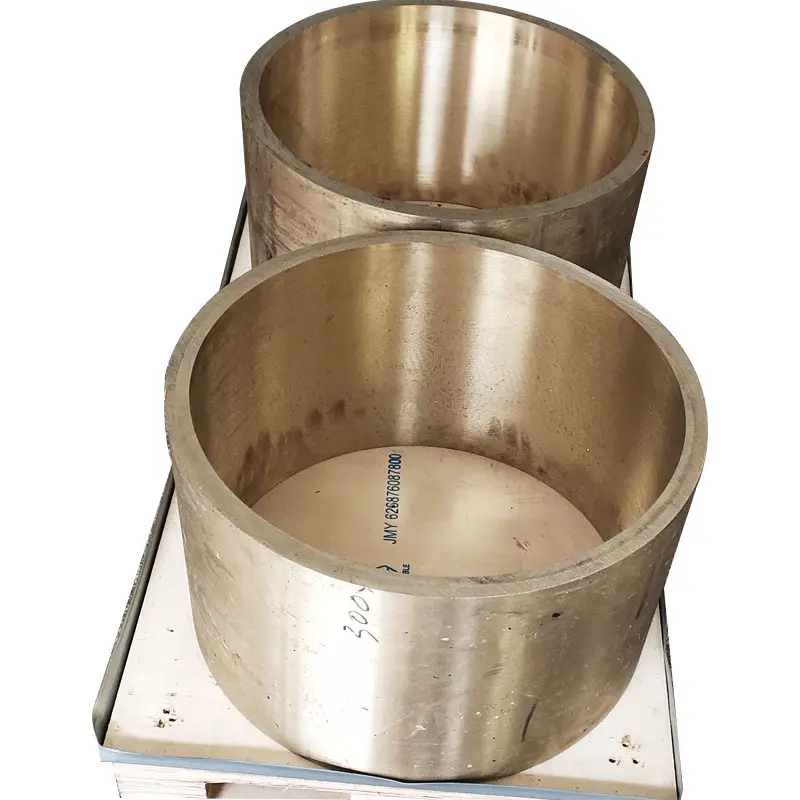
導入
アルミニウムブロンズパイプは、強度、耐食性、耐久性の並外れた組み合わせにより、さまざまな業界で大きな人気を博しています。この包括的なガイドでは、アルミニウムブロンズパイプの特性、アプリケーション、製造プロセス、およびメンテナンスを調査し、エンジニア、調達スペシャリスト、および業界の専門家に貴重な洞察を提供します。
構成と特性
アルミニウムブロンズパイプは、主要な合金要素としてアルミニウムを含む銅ベースの合金です。アルミニウムを追加すると、材料の特性が大幅に向上し、アプリケーションの要求に適しています。
化学組成
アルミニウムブロンズパイプの典型的な組成は、特定のグレードによって異なります。これは、パイプに使用される一般的なアルミニウムブロンズ合金の組成を示すテーブルです。
| 合金 | 銅(%) | アルミニウム(%) | 鉄(%) | で (%) | マンガン(%) | 他の (%) |
|---|---|---|---|---|---|---|
| C95200 | 86-89 | 8.5-9.5 | 2.5-4.0 | – | – | 0最大.25 |
| C95400 | 85-89 | 10-11.5 | 3.0~5.0 | – | 0最大.5 | 0最大.25 |
| C95500 | 78-82 | 10-11.5 | 3.5-4.5 | 4.0-5.0 | 0最大.5 | 0最大.25 |
| C95800 | 79-82 | 8.5-9.5 | 3.5-4.5 | 4.0-5.0 | 0.8-1.5 | 0最大.25 |
主要なプロパティ
アルミニウムブロンズパイプは、さまざまなアプリケーションに最適なユニークなプロパティセットを提供します。
- 耐食性:海水、汽水、および多くの化学物質に対する優れた耐性。
- 高強度:標準的な銅合金と比較した優れた強度。
- 耐摩耗性:耐摩耗性と侵食に対する良好な抵抗。
- 熱伝導率:ステンレス鋼よりも優れた中程度の熱伝導率。
- 非火花性:爆発環境での使用に適しています。
- 生物付着耐性:自然に海洋成長に耐性があります。
アプリケーション
アルミニウムブロンズパイプは、独自の特性により、さまざまな業界でアプリケーションを見つけます。主要なアプリケーションを要約するテーブルです。
| 業界 | アプリケーション |
|---|---|
| マリン | 海水配管システム、プロペラシャフト、ポンプケース |
| Oil & Gas | オフショアプラットフォーム、海底機器、バルブボディ |
| 化学処理 | 熱交換器、反応容器、蒸留カラム |
| 発電 | コンデンサーチューブ、冷却水システム、バルブコンポーネント |
| 航空宇宙 | 油圧システム、着陸装置コンポーネント |
| マイニング | スラリーパイプライン、ポンプコンポーネント、スクリーニング装置 |
ケーススタディ:海水冷却システム
顕著な用途では、沿岸発電所がそのステンレス鋼の海水冷却パイプをC95800アルミニウムブロンズパイプに置き換えました。結果は印象的でした:
- メンテナンスコストの40%の削減
- 熱伝達効率の25%の増加
- 15年から25年に延長されたシステム寿命
製造工程
アルミニウムブロンズパイプは、特定の要件を満たすためにさまざまなプロセスを使用して製造されています。
- 遠心鋳造:優れた寸法精度の大きな直径パイプに最適です。
- 押し出し:一貫した壁の厚さの小さな直径パイプに適しています。
- 継続的なキャスト:標準サイズの大量生産に効率的です。
- 溶接製の製造:特殊なアプリケーション用のカスタムシェイプとサイズ。
品質管理対策
最高品質を確保するために、メーカーは厳格な品質管理措置を実施します。
- 超音波検査やX線撮影などの非破壊検査(NDT)方法
- 分光測定を使用した化学組成分析
- 引張強度と硬度テストを含む機械的特性テスト
- 寸法検査と耐性チェック
選択ガイド
アプリケーション用の適切なアルミニウムブロンズパイプを選択するには、いくつかの要因を考慮する必要があります。
- 動作環境:温度、圧力、化学物質への曝露などの要因を考慮してください。
- 機械的要件:強度、硬度、耐摩耗性のニーズを評価します。
- 耐食性:アプリケーションに存在する特定の腐食剤を評価します。
- コストに関する考慮事項:初期コストと長期的なパフォーマンスとメンテナンスの節約とのバランス。
他の材料との比較
これは、他の一般的な配管材料を備えたアルミニウムブロンズパイプの比較表を紹介します。
| 財産 | アルミニウム青銅 | ステンレス鋼 | 炭素鋼 | 銅ニッケル |
|---|---|---|---|---|
| 耐食性 | 素晴らしい | 良い | 貧しい | とても良い |
| 強さ | 高い | 高い | 適度 | 適度 |
| 料金 | 高い | 適度 | 低い | 適度 |
| 重さ | 適度 | 高い | 高い | 適度 |
| 熱伝導率 | 適度 | 低い | 高い | 適度 |
| 生物付着耐性 | 素晴らしい | 貧しい | 貧しい | 良い |
インストールとメンテナンス
適切な設置とメンテナンスは、アルミニウムブロンズパイプのパフォーマンスと寿命を最大化するために重要です。
インストールベストプラクティス
- 互換性のあるフィッティングとガスケットを使用して、ガルバニック腐食を防ぎます。
- 適切なサポートと固定を実装して、パイプのストレスを最小限に抑えます。
- 参加が必要な場合は、推奨溶接手順に従ってください。
- 試運転前に徹底的なフラッシングとクリーニングを実施します。
メンテナンスのヒント
- 摩耗や腐食の兆候の定期的な検査
- 海洋の成長またはスケールの蓄積を除去するための適切なクリーニング
- 水没した用途向けの陰極保護システム
- 冷却システムにおける水化学の監視
将来の傾向
アルミニウムブロンズパイプ業界は、新しいトレンドとイノベーションで進化しています。
- 高度な合金:特性が強化された新しいアルミニウムブロンズ組成の開発。
- 添加剤の製造:複雑なパイプ形状の3D印刷技術の探索。
- スマート配管システム:リアルタイムの監視と予測メンテナンスのためのセンサーの統合。
- 持続可能な生産:リサイクルおよび環境に優しい製造プロセスに焦点を当てます。
結論
アルミニウムブロンズパイプは、さまざまな業界での挑戦的なアプリケーションに理想的なプロパティの魅力的な組み合わせを提供します。その特性、製造プロセス、選択基準を理解することにより、エンジニアと調達の専門家は、配管システムのパフォーマンスと費用対効果を最適化するための情報に基づいた決定を下すことができます。
業界が進化し続けるにつれて、アルミニウムブロンズパイプは、特に腐食性と高ストレス環境で、現代の産業用途の要求に対処する上でますます重要な役割を果たす可能性があります。
